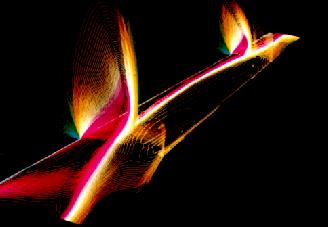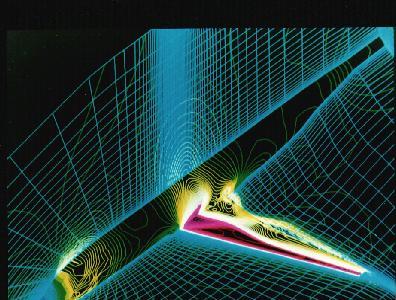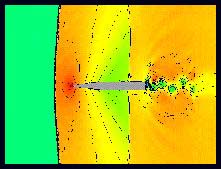Main
Research in the Past
Improvement
of the Transonic Small Disturbance Theory
Theoretical research
on transonic flows was conducted during the period of a graduate student,
department of aeronautics, faculty of Engineering, University of Tokyo. The
work was done at the Institute of Space and Aeronautical Science, University
of Tokyo under the guidance of Prof. Keiichi Karashima. First-order small
disturbance equation was mainly used for the transonic flow analysis at that
time. We formulated the second-order equation, and evaluated the effect of
second-order terms by the numerical simulations both for the first and second-order
equations (publication, Transactions of the Japan Society for Aeronautics
and Astronautics ( JSASS), 1978). As a ph D. thesis, a new coupling method
for the transonic small disturbance potential equation for the inviscid flow
region and the boundary layer equations was developed. Separated boundary
layer could be handled by this coupling method (Proc. ICNMFD1981, Springer-Verlag)
. The NASA post-conference report for the ICNMFD conference picked up the
method as one of the possible candidates for the future development of the
CFD research tools. This initiated the NRC fellowship at NASA Ames R. C.
from 1981.
Research with Prof. Karashima (presently Prof. of Nishi-Nihon Kogyo Daigaku)
Numerical
Simulations of the Leading-Edge separation Vortex Flow Filed over a Delta
and Double-Delta Wings
 This
was the main topic of the research as an NRC Research Associate during 1881-81,
and as a senior NRC Research Associate at NASA Ames Research Center during
1986-1987. Three-dimensional compressible Navier-Stokes simulation was first
demonstrated by T. Pulliam and J. L. Steger in 1979. The result and the later effort showed that
the viscous flows over the bodies can be well simulated. Although some of
the results demonstrated separated flows over the hemisphere cylinder, people
were not confident of the capability of simulating the leading-edge separation
vortices(LESV) over the delta wing, which was really required for the design
of fighter-type wings and aircraft. In the AIAA CFD conference in 1983, we
presented the simulation of the LESV using three-dimensional compressible
Navier-Stokes equations. In the same conference, Prof. Krause's group from
Univ. Achen showed the similar simulation using incompressible Navier-Stokes
equations. These were probably the first success of the LESV simulation using
Navier-Stokes equations. The research in 1982-83(AIAA Paper 83-1908,84-1550,
85-1563, etc.) proved the effect of the Mach number, turbulent B. L. and others
were discussed as well as that such simulations were possible.
This
was the main topic of the research as an NRC Research Associate during 1881-81,
and as a senior NRC Research Associate at NASA Ames Research Center during
1986-1987. Three-dimensional compressible Navier-Stokes simulation was first
demonstrated by T. Pulliam and J. L. Steger in 1979. The result and the later effort showed that
the viscous flows over the bodies can be well simulated. Although some of
the results demonstrated separated flows over the hemisphere cylinder, people
were not confident of the capability of simulating the leading-edge separation
vortices(LESV) over the delta wing, which was really required for the design
of fighter-type wings and aircraft. In the AIAA CFD conference in 1983, we
presented the simulation of the LESV using three-dimensional compressible
Navier-Stokes equations. In the same conference, Prof. Krause's group from
Univ. Achen showed the similar simulation using incompressible Navier-Stokes
equations. These were probably the first success of the LESV simulation using
Navier-Stokes equations. The research in 1982-83(AIAA Paper 83-1908,84-1550,
85-1563, etc.) proved the effect of the Mach number, turbulent B. L. and others
were discussed as well as that such simulations were possible.
In 1986 as a second stay in NASA Ames Research Center, the flow simulation
was extended for the more elaborate simulations for the strake-delta wing
which is more realistic geometry. The flowfield was much more complex
 than
that of the simple delta wing as strake, and main wing vorticies interact
each. Two types of vortex breakdown observed in the experiments appeared in
the flow simulation(NASA Press Release). One is bubble breakdown and the other
is spiral breakdown. The detailed analysis identified the flow structure that
might cause and decide the type of breakdown. The analysis also showed some
histerisis exists even in the numerical simulation at high angle of attack
near the vortex breakdown. (AIAA Paper 87-1229, International Journal of Numerical
Methods inFluids,1988, AIAA Journal,1989). This research was continued by
the other researchers especially for the F-18 fighters( AIAA Paper88-2558,
AIAA Paper 89-0341,etc.).
than
that of the simple delta wing as strake, and main wing vorticies interact
each. Two types of vortex breakdown observed in the experiments appeared in
the flow simulation(NASA Press Release). One is bubble breakdown and the other
is spiral breakdown. The detailed analysis identified the flow structure that
might cause and decide the type of breakdown. The analysis also showed some
histerisis exists even in the numerical simulation at high angle of attack
near the vortex breakdown. (AIAA Paper 87-1229, International Journal of Numerical
Methods inFluids,1988, AIAA Journal,1989). This research was continued by
the other researchers especially for the F-18 fighters( AIAA Paper88-2558,
AIAA Paper 89-0341,etc.).
Collaborative research with Dr. Paul Kutler, Dr. Terry L. Holst and Dr. Lewis
B.Schiff. Also great help by Dr .Joseph L. Steger.
Transonic
Flow Analysis for Practical Wing and Wing-Fuselage Configurations
 From
1984 to 1986 at the National Aerospace Laboratory Japan, we develop the three-dimensional
Implicit Navier-Stokes code using LU-ADI algorithm. The code was applied to
the wing configuration designed for so-called YXX (7J7 from the Boeing side)
project. This code, or a part of the code is still used by many researchers
in some foreign as well as Japan. This was the first 3-D Navier-Stokes simulation
for the transonic flows over a practical wing in the world. The code was extended
to the simulation for the wing-fuselage configuration. The result showed the
capability of the CFD method for the analysis and supplied basic data for
the better design (two AIAA Journal articles 1987).The result also showed
the flow structure near the wing-body juncture. The research was taken to
be one of the important topics in the year
1986 in the field of both aerodynamics and applied aerodynamics in the journal,
Aeronautics & Astronautics (AIAA) The collaborative research with Shigeru
Obayashi (graduate student at the time of research, now associate Prof. IFS,
Tohoku University.
From
1984 to 1986 at the National Aerospace Laboratory Japan, we develop the three-dimensional
Implicit Navier-Stokes code using LU-ADI algorithm. The code was applied to
the wing configuration designed for so-called YXX (7J7 from the Boeing side)
project. This code, or a part of the code is still used by many researchers
in some foreign as well as Japan. This was the first 3-D Navier-Stokes simulation
for the transonic flows over a practical wing in the world. The code was extended
to the simulation for the wing-fuselage configuration. The result showed the
capability of the CFD method for the analysis and supplied basic data for
the better design (two AIAA Journal articles 1987).The result also showed
the flow structure near the wing-body juncture. The research was taken to
be one of the important topics in the year
1986 in the field of both aerodynamics and applied aerodynamics in the journal,
Aeronautics & Astronautics (AIAA) The collaborative research with Shigeru
Obayashi (graduate student at the time of research, now associate Prof. IFS,
Tohoku University.
Development
Numerical Algorithms for Compressible Flows
We have developed an efficient algorithm for the solution method of compressible viscous flows associated with the transonic flow simulations above. The LU-ADI implicit time integration method was originally developed by Shigeru Obayashi in 1984 and improved in 1986 for two-dimensional flows and extended to three-dimensional flows in1986 (AIAA paper 86-338, AIAA Paper 86-513) . This algorithm was implemented in LANS2D and LANS3D codes and these codes are used by many researchers not only in Japan but also in Turkey and Canada even now. A new idea of the interface method for the overset zonal grid was developed in 1995. It is called “Fortified Solution Algorithm (FSA)” and is one of the flexible interface methods although it can be classified into the category of the CHIMERA grid method. There are several features that FSA is better than the so-called CHIMERA method as written in the JCP article (Journal of Computational Physics 1995 ).In 1999, a new efficient integration algorithm called FF-SGS (Four-factored Symmetric Gauss Seidel) was developed. The code can be used as a space-marching code was well as time marching code (ICNMFD 1997, AIAA Paper 97-2105, AIAA Journal Vol. 37, No.1, Jan. 1999). The LANS2D, LANS3D codes with the FSA overset grid feature are the main simulations codes In the laboratory. The code using FF-SGS will take Its place soon after the verifications.
Experimental
and Computational Study on the Supersonic
Intake Aerodynamics
As a collaboration
research, flow field analysis of the supersonic Intake was conducted in 1990's. As the flow field Is very complex, we made
a simplified intake model with cavity for the experiment. The steady and unsteady flow measurement showed
the structure of the flow field. The
effect of the sidewall, aspect ratio of the cavity and other important features
of supersonic intake was discussed (AIAA paper 95-2213, JSME (in Japanese)
1996 and else.). Also computational
analysis was conducted.
Research with
visiting researchers (Mr. Shinichi Kuroda and Dr. Kazuyuki Sakamoto from Ishikawajima
Heavy Industries (IHI) at the ISAS. The
result became
 the
main body of the ph. D thesis of Kazuyuki Sakmamoto
the
main body of the ph. D thesis of Kazuyuki Sakmamoto
Blast
wave and shock wave propagation over Ground Surface Geometries
The research was
carried out in 1994 associated with the safety distance estimation of the
M-V rocket development. The numerical
simulation using Euler equations showed that the ground surface geometries
strongly influence the strength of the blast wave (Transaction of JSASS, 1993).
Detailed discussion for the accuracy of the numerical simulation was carried
out before the final solution for the realistic ground surface geometry (Proc.
ISCFD1995, etc.). The research also
showed the unsteady three-dimensional flow field phenomenon by the shock wave
. Comparison of the two approaches by structured
and unstructured grid system was carried out and it was shown that structured
grid method is more efficient than the unstructured grid method with solution
adaptive capability at least for the problems under consideration. The unstructured grid method was then applied
to the shock-shock interaction flow field analysis at high Mach numbers for
the future research of spaceplane aerodynamics (AIAA Paper 96-2445, ICNMFD1996,
etc.).
The research with
Dr. Fumio Shimizu (currently research associate at Kyushu Institute of Technology)
, the research graduate student and post-doctoral fellow from Tokyo Noko University. The unstructured grid methods and the applications
were the work originated by Dr. Dima Sharov (unfortunately passed away in
2001 in U.S.) and extended by Dr. Koji Miyaji (currently assistant professor
at Yokohama National University), the graduate student of Univ. Tokyo.
Dr. Dima Sharov was a very intelligent researcher I have seen.
Wish he could live longer and use his talent for the aerospace engineering.
Unsteady
Supersonic Combustion around the projectile
There occurs a wavy and unsteady
structure of the combustion front
when a projectile flies in the
combustible gas at supersonic speed. As
only the limited amount of data has been obtained in the ballistic range
experiments in the past, we tried to identify the mechanism using the numerical
simulations. The simulation results
showed that the flow model proposed based on the experiment was correct. The new improved model was proposed based on
the analysis of the huge unsteady data obtained in the simulation (AIAA Journal,
1995, 1996, etc.). General method for
the estimation of the instability pattern was newly proposed. In this model, the flow pattern can be
estimated when the body length, pressure condition and other limited important
parameters was given.
The research with Dr. Akiko Matsuo (currently associate professor of Keio University) as a research student at the ISAS from Nagoya University and a post-doctoral fellow at the ISAS.
High Speed Aerodynamics over Rockets
 High
speed aerodynamics over rockets are studied from many aspects.
In 1993, the effect of the spike in front of the rockets was studied
both numerically and experimentally (AIAA Paper 93-0887, Journal of Spacecraft
and Rockets, 1994). The
result showed the flow physics that reduce the drag of the rocket by the spike
attachment. The effect of small elements
(such as flanges or nozzles) to the total drag of the rockets was studied
in 1998 in conjunction with M-V rocket development. The result reproduced the fact that these elements
increase the total drag almost 30%, and the effect is not negligible.
The result also indicated that the interaction of each element is small,
and therefore the effect of each element can be evaluated independently.
The overset zonal method using FSA was used for the analysis. The two-phase nozzle flow analysis was continuously
underway since 1983 (AIAA Paper 83-0041). Some work was done for the analysis of the cause
of M-V launching failure in 2000. Also conducted was the accuracy evaluation of the CFD for rocket
aerodynamics.
High
speed aerodynamics over rockets are studied from many aspects.
In 1993, the effect of the spike in front of the rockets was studied
both numerically and experimentally (AIAA Paper 93-0887, Journal of Spacecraft
and Rockets, 1994). The
result showed the flow physics that reduce the drag of the rocket by the spike
attachment. The effect of small elements
(such as flanges or nozzles) to the total drag of the rockets was studied
in 1998 in conjunction with M-V rocket development. The result reproduced the fact that these elements
increase the total drag almost 30%, and the effect is not negligible.
The result also indicated that the interaction of each element is small,
and therefore the effect of each element can be evaluated independently.
The overset zonal method using FSA was used for the analysis. The two-phase nozzle flow analysis was continuously
underway since 1983 (AIAA Paper 83-0041). Some work was done for the analysis of the cause
of M-V launching failure in 2000. Also conducted was the accuracy evaluation of the CFD for rocket
aerodynamics.
Flow
Field Analysis of the Supersonic Projectile Overtaking the Preceding Shock
Wave
 Very complicated flow
field is created when a projectile overtakes the preceding shock wave.
Both subsonic and supersonic flow field appears under certain condition,
and that might cause the instability of the direction of the projectile.
The work was associated with one of the satellite project in the ISAS,
but similar flow field can be observed also in free flight experiment using
shock tunnel and muzzle flows. Both
the two-dimensional and three-dimensional analysis was conducted with some
estimation of the effect to the projectile flight (Transaction of the JSASS,
1998 and Journal of Spacecraft and Rockets, 1998).
Very complicated flow
field is created when a projectile overtakes the preceding shock wave.
Both subsonic and supersonic flow field appears under certain condition,
and that might cause the instability of the direction of the projectile.
The work was associated with one of the satellite project in the ISAS,
but similar flow field can be observed also in free flight experiment using
shock tunnel and muzzle flows. Both
the two-dimensional and three-dimensional analysis was conducted with some
estimation of the effect to the projectile flight (Transaction of the JSASS,
1998 and Journal of Spacecraft and Rockets, 1998).
The research with Dr. Rikio Watanabe,
and his ph. D thesis as a research
student at the ISAS from Tokyo Noko University.
Post
processing of the CFD data and Visualization Methods
Post processing and visualization is an important part of the CFD research. We started the work when I came back from U. S. in 1987.The software called `Post-kun` was developed initially on the SGI workstation using GL library. With the advances of computes`s hardware and software and with the spread of visualization, the `Post-kun` was now available and any workstations or PC`s under UNIX or LINUX operating system. There are probably more than 50 user sites mainly in Japan. The `Post-kun` is a free software and has a lot of good features that are not included in any commercial software available. It is handy software and does not require much memory like most of the commercial software. All the documents for the manuals and tutorials for both for beginners and advanced users are available (sorry written in Japanese). The analysis of the post processing of the CFD was continuously conducted and some of the tools were developed in the past. One example is the simulation of experimental visualization methods.The process of, for instance, Schlieren pictures, shadowgraph patterns, interferograms and else was numerically carried out for the CFD data, which produces the images simulating the experimental visualization. The fair comparison became possible by the effort. Nowadays, many people use this techniques all oer the world (ICNMFD at Oxford, 1990, International Journal of Computational Fluid Dynamics, 1994).The newer tools for the analysis of large amount of data were developed under the budget of STA from 1992 to 1996.
The software
development was mainly done by Dr. Yoshiaki Tamura, the research associate
of my laboratory from 1989-96) currently associate professor of Toyo University.
Analysis
of the Dynamic Instability of Reentry Capsules
In conjunction with the project MUSES-C,
some research was done for the capsule aerodynamics. This type of capsules has
a tendency to oscillate in transonic flow regime. The phenomenon has been known quite some time but the mechanism
was not analysed at all. The
phenomenon only occurs in transonic flows, and therefore should be associated
with the shock wave structure. We
conducted the analyis of the capsule aerodynamics from many view points and
revealed the flow physics of the mechanism (AIAA Paper 98-4451, 99-3414, 2000-2603,
AIAA Journal 2001).